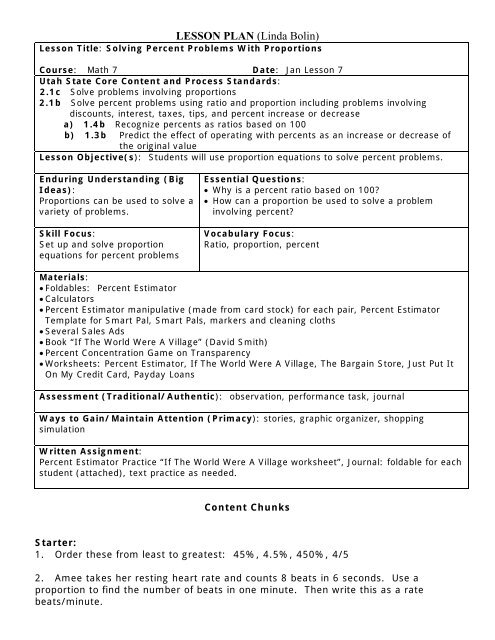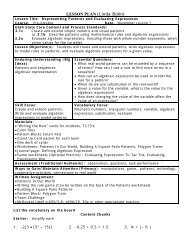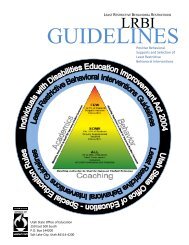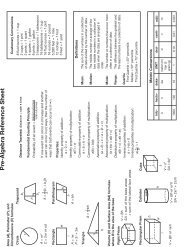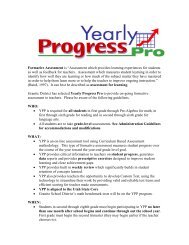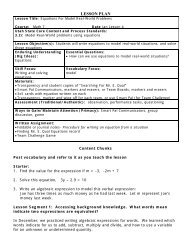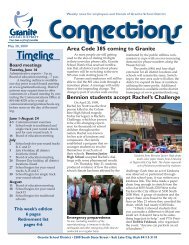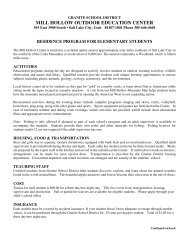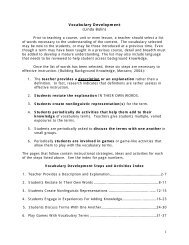LESSON PLAN (Linda Bolin) - Granite School District
LESSON PLAN (Linda Bolin) - Granite School District
LESSON PLAN (Linda Bolin) - Granite School District
Create successful ePaper yourself
Turn your PDF publications into a flip-book with our unique Google optimized e-Paper software.
<strong>LESSON</strong> <strong>PLAN</strong> (<strong>Linda</strong> <strong>Bolin</strong>)<br />
Lesson Title: Solving Percent Problems With Proportions<br />
Course: Math 7 Date: Jan Lesson 7<br />
Utah State Core Content and Process Standards:<br />
2.1c Solve problems involving proportions<br />
2.1b Solve percent problems using ratio and proportion including problems involving<br />
discounts, interest, taxes, tips, and percent increase or decrease<br />
a) 1.4b Recognize percents as ratios based on 100<br />
b) 1.3b Predict the effect of operating with percents as an increase or decrease of<br />
the original value<br />
Lesson Objective(s): Students will use proportion equations to solve percent problems.<br />
Enduring Understanding (Big<br />
Ideas):<br />
Proportions can be used to solve a<br />
variety of problems.<br />
Skill Focus:<br />
Set up and solve proportion<br />
equations for percent problems<br />
Essential Questions:<br />
• Why is a percent ratio based on 100?<br />
• How can a proportion be used to solve a problem<br />
involving percent?<br />
Vocabulary Focus:<br />
Ratio, proportion, percent<br />
Materials:<br />
• Foldables: Percent Estimator<br />
• Calculators<br />
• Percent Estimator manipulative (made from card stock) for each pair, Percent Estimator<br />
Template for Smart Pal, Smart Pals, markers and cleaning cloths<br />
• Several Sales Ads<br />
• Book “If The World Were A Village” (David Smith)<br />
• Percent Concentration Game on Transparency<br />
• Worksheets: Percent Estimator, If The World Were A Village, The Bargain Store, Just Put It<br />
On My Credit Card, Payday Loans<br />
Assessment (Traditional/Authentic): observation, performance task, journal<br />
Ways to Gain/Maintain Attention (Primacy): stories, graphic organizer, shopping<br />
simulation<br />
Written Assignment:<br />
Percent Estimator Practice “If The World Were A Village worksheet”, Journal: foldable for each<br />
student (attached), text practice as needed.<br />
Content Chunks<br />
Starter:<br />
1. Order these from least to greatest: 45%, 4.5%, 450%, 4/5<br />
2. Amee takes her resting heart rate and counts 8 beats in 6 seconds. Use a<br />
proportion to find the number of beats in one minute. Then write this as a rate<br />
beats/minute.
Lesson Segment 1: Why is a percent ratio based on 100? How can a<br />
proportion be used to solve a problem involving percent?<br />
Do Stand-Up If, where the students stand for a statement if they believe it is true. Ask a few<br />
students to justify their choice to stand or not.<br />
1. Percent means a part out of 100.<br />
2. If we say 50% of our class prefers chocolate ice cream, this means 50 of us prefer chocolate<br />
ice cream.<br />
3. 50% of our class would be about 18 people.<br />
Q. So if 50% means 50 out of every 100, how can we know how many that is out of 36 (or<br />
whatever number of students is in the class)?<br />
Do “Vizualizing Percents In Our World” with the students, shading in the appropriate percent as<br />
they visualize the fraction of the whole given in each problem.<br />
To help students visualize the percent of a number, give student pairs a Percent Estimator<br />
Foldable and Smart Pal with Percent Estimator Practice worksheet. The Percent Estimators come<br />
four to a page. Copy them on card stock and slit the 0% line on each bar to allow a slider strip to<br />
be moved up and down the fraction and the percent bars. Cut 1 ½ “ strips from a different color<br />
card stock to use as slider bars. They should be inserted in the slit on each bar, so there are 2<br />
sliders per Estimator.<br />
Students work together to slide a covered card stock bar on the % side and on the part to total<br />
number side to see the ratios. They should also shade the Smart Pal and Practice worksheet for<br />
both % and part to total. Using the bar, they should try to determine about what number out of<br />
the total number given represents the percent given. After estimating using the Percent<br />
Estimator, have the students set up a proportion using part/total = %/100 as the ratios, and have<br />
them find the exact number.<br />
a) 25% of 20 b) 40% of 30 c) 10% of 50 d) 75% of 10<br />
Ask students to describe what 150% of a number would look like, 200%, etc.<br />
Q. What if we knew the part to total ratio, but didn’t know what percent that would be. How<br />
could we find a percent?<br />
Repeat the visualization with the Percent Estimator, worksheet, and Smart Pals. This time have<br />
them estimate what the part to total ratio bar would look like and slide the bar up the % side to<br />
estimate the percent. Use:<br />
a) 30/40 is what %? b) 12/48 is what %? c) 10/25 is what % d) 1/12 is what %?<br />
Lesson Segment 2: How can proportions be used to solve percent problems?<br />
Read parts of the book, “If The World Were A Village” by David Smith. Use the attached<br />
worksheet to find out how many people that would be in the classroom if the class were typical of<br />
the world.
Lesson Segment 3: How can proportions be used to solve tax and interest<br />
problems?<br />
Use appropriate text problems involving tax and interest to practice setting up<br />
proportions to solve. Students will need to determine what the part represents, and<br />
what the total represents in the first ratio if you use:<br />
__Part__ = _%_<br />
Total 100<br />
If you are finding the total cost after tax is being paid, it is helpful for students to<br />
consider the part as original price plus tax, the total as original price, and the percent<br />
as 100% plus the tax percent. To help with this have students model purchasing<br />
something and ask questions such as:<br />
Q. What is the tax?<br />
Q. Is tax added or subtracted for the item price?<br />
Q. Will the total cost including tax be more or less than 100% of the original price?<br />
The attached Shopping Spree Worksheet helps students connect to their world. Give<br />
groups several sales ads to look through to spend their “$1000” limit.<br />
Lesson Segment 4: How can proportions be used to solve percent increase<br />
and decrease problems?<br />
Your text will also have plenty of practice problems for increase and decrease that can<br />
be used. Again it is useful for students to consider whether the question wants them<br />
to find more than 100% of the original (increase) or less than 100% of the original<br />
(decrease). Helping students determine<br />
Q. What is the increase or decrease?<br />
Q. Will the result be more or less than 100% of the original?<br />
The attached “The Bargain Store” worksheet can be used as a role model. Students<br />
often mistakenly think taking additional percent off can eventually result in paying<br />
nothing. This worksheet investigates the idea of accumulated percent decrease.<br />
Lesson Segment 4: Practice Game<br />
Play Percent Concentration (attached)
Visualizing Percents in Our World<br />
Name__________________<br />
For each of the following, shade the approximate given percent in the box<br />
and shade or circle the percent on the sketch. Label the percent on the<br />
sketch.<br />
1. I got 25 % off the cost of a shirt. 2. My sister is about 70% my height.<br />
100%<br />
90%<br />
80%<br />
70%<br />
60%<br />
50%<br />
40%<br />
30%<br />
20 %<br />
10 %<br />
$1 $1<br />
$1<br />
$1 $1<br />
100%<br />
90%<br />
80%<br />
70%<br />
60%<br />
50%<br />
40%<br />
30%<br />
20 %<br />
10 %<br />
3. I got 80% of the problems on 4. I ate 10% of the cookies.<br />
my last test correct.<br />
100%<br />
90%<br />
80%<br />
70%<br />
60%<br />
50%<br />
40%<br />
30%<br />
20 %<br />
10 %<br />
%Test<br />
Name<br />
1. xxx 2. xxx<br />
3. xxx 4. xxx<br />
5. xxx 6. xxx<br />
7. xxx 8. xxx<br />
9. xxx 10. xxx<br />
11. xxx 12. xxx<br />
13. xxx 14. xxx<br />
15. xxx 16. xxx<br />
17. xxx 18. xxx<br />
19. xxx 20. xxx<br />
100%<br />
90%<br />
80%<br />
70%<br />
60%<br />
50%<br />
40%<br />
30%<br />
20 %<br />
10 %
Total % Total #<br />
100%<br />
90%<br />
80%<br />
70%<br />
60%<br />
50%<br />
40%<br />
30%<br />
20%<br />
10%<br />
0% 0<br />
Total % Total #<br />
100%<br />
90%<br />
80%<br />
70%<br />
60%<br />
50%<br />
40%<br />
30%<br />
20%<br />
10%<br />
0% 0<br />
Total % Total #<br />
100%<br />
90%<br />
80%<br />
70%<br />
60%<br />
50%<br />
40%<br />
30%<br />
20%<br />
10%<br />
0% 0<br />
Total % Total #<br />
100%<br />
90%<br />
80%<br />
70%<br />
60%<br />
50%<br />
40%<br />
30%<br />
20%<br />
10%<br />
0% 0
Percent Estimator Practice<br />
Name_______________<br />
1. 4. 7.<br />
100% Total ___<br />
100% Total ___ 100% Total ___<br />
100%<br />
100%<br />
100%<br />
90%<br />
80%<br />
90%<br />
80%<br />
90%<br />
80%<br />
70%<br />
60%<br />
50%<br />
40%<br />
30%<br />
20%<br />
10%<br />
70%<br />
60%<br />
50%<br />
40%<br />
30%<br />
20%<br />
10%<br />
70%<br />
60%<br />
50%<br />
40%<br />
30%<br />
20%<br />
10%<br />
2.<br />
100% Total ___<br />
100%<br />
90%<br />
80%<br />
70%<br />
60%<br />
50%<br />
40%<br />
30%<br />
20%<br />
10%<br />
5.<br />
100% Total ___<br />
100%<br />
90%<br />
80%<br />
70%<br />
60%<br />
50%<br />
40%<br />
30%<br />
20%<br />
10%<br />
8.<br />
100% Total ___<br />
100%<br />
90%<br />
80%<br />
70%<br />
60%<br />
50%<br />
40%<br />
30%<br />
20%<br />
10%<br />
3.<br />
100% Total ___<br />
100%<br />
90%<br />
80%<br />
70%<br />
60%<br />
50%<br />
40%<br />
30%<br />
20%<br />
10%<br />
6.<br />
100% Total ___<br />
100%<br />
90%<br />
80%<br />
70%<br />
60%<br />
50%<br />
40%<br />
30%<br />
20%<br />
10%<br />
9.<br />
100% Total ___<br />
100%<br />
90%<br />
80%<br />
70%<br />
60%<br />
50%<br />
40%<br />
30%<br />
20%<br />
10%
Name_________________<br />
Since the “World Village” described in the book has exactly 100 people in it, we can use percent proportions<br />
to find some interesting data for our class.<br />
1. What is the total number of people in our<br />
classroom? Explain how you could find the<br />
number of us that makes up 10% of this class.<br />
7. If we were in proportion to the World Village,<br />
how many of us would always be hungry?<br />
2. If we were in proportion to the World Village,<br />
how many of us would come from North<br />
America?<br />
3. If we were in proportion to the World Village,<br />
how many of us would speak English?<br />
4. If we were in proportion to the World Village,<br />
how many of us would be between 10 and 19<br />
years old?<br />
5. If we were in proportion to the World Village,<br />
how many of us would be Muslim? Christian?<br />
8. If we were in proportion to the World Village,<br />
how many of us would spend a large part of the<br />
day trying to find safe water to drink?<br />
9. If we were in proportion to the World Village,<br />
how many of us would not be able to read?<br />
10. If we were in proportion to the World<br />
Village, how many of us would make less than<br />
$1.00 per day?<br />
11. If we were in proportion to the World Village,<br />
how many of us would not have electricity or<br />
Television?<br />
6. If we were in proportion to the World Village,<br />
how many chickens would there be?<br />
12. If we were in proportion to the World Village,<br />
how many people will be in our class in 5 years?
World Village Facts 2002<br />
If the world were shrunk to a village of 100 people where all conditions were proportional, these<br />
are the facts about the village:<br />
5 would be from North America<br />
9 would speak English<br />
19 are between the ages of 10 and 19<br />
19 are Muslims. 32 are Christians<br />
189 chickens are in our Village<br />
60 are always hungry<br />
25 spend a large part of the day looking for safe water<br />
17 of the 88 people old enough to read, can’t read at all<br />
20 make less than $1.00 per day<br />
24 have no electricity and no water<br />
The size of our class would double every five years.
The Bargain Store<br />
Name______________<br />
You go into a clothing store with $100. The banner on the window says 50% off<br />
everything in the store. As you walk into the store, you see a special room where<br />
everything is marked an additional 25% off. In that room is a long table with a sign<br />
that says, “Take another 20% off these items”.<br />
Shade the box on the right to show the score for the next five questions.<br />
1. Predict what an item on the table that was originally $40<br />
would cost you.<br />
% Ratio<br />
Score Score<br />
100<br />
5/5<br />
Computing:<br />
2. What would the $40 item cost if it was marked 50% off?<br />
Show work.<br />
3. What would that item cost if an additional 25% were<br />
taken off? Show work.<br />
80<br />
60<br />
40<br />
4/5<br />
3/5<br />
2/5<br />
4. Now, what would the item cost if another 20% were<br />
taken off? Show your work.<br />
20<br />
1/5<br />
5. How did your prediction compare to the actual cost?<br />
0<br />
0/5<br />
6. Estimate how much you would spend on an item from the long table that originally<br />
cost $50. If tax were 6%, what the approximate cost be? Explain your reasoning.<br />
7. How much would you expect to pay for an item from the long table with an original<br />
price of $80? If tax were 7.5%, what would the cost be? Show your reasoning below.<br />
8. Could you buy an item from the long table that was originally $500? Explain.
Name________________________<br />
Date _______<br />
Just Put it on my Credit Card?<br />
Which Credit Card Company uses which advertising slogan?<br />
1) Roses: $50. Candy: $35. The smile on her face: PRICELESS!<br />
2) It pays to ....<br />
3) It’s everywhere you want to be...<br />
4) What’s In Your Wallet<br />
a) MasterCard b) Discover c) Visa d) Capital One<br />
Which credit card company do you prefer? How does their slogan appeal to you? How does<br />
their slogan encourage you to buy items using their card?<br />
$1000 Shopping Spree<br />
Your credit card company has given you a $1000 limit. You are going on a shopping spree.<br />
Choose from the sales ads to reach your card limit.<br />
Item<br />
# of these you will<br />
buy<br />
Price each<br />
Total for this<br />
item<br />
Total spent: ________________
The Bill<br />
Your company is very nice. They do not expect you to pay this back all at once. You may<br />
make minimum payments each month of $30. Your Credit Card Company will charge you<br />
1.5% interest on the unpaid balance each month. The formula for finding the amount of<br />
interest you will pay each month is prt = I, where p is the principle or balance, r is the<br />
percent rate of interest (written as a decimal), t is the time, and I is the $ amount of interest.<br />
Use the table below to organize and calculate the balance each month for 6 months.<br />
Month #<br />
1<br />
Beginning<br />
Balance $<br />
(p)<br />
Rate<br />
(%)<br />
(r)<br />
Time<br />
(t)<br />
Amount of<br />
Interest<br />
(I)<br />
Ending<br />
Balance<br />
Payment $<br />
2<br />
3<br />
4<br />
5<br />
6<br />
How long do you predict it would take you to pay off your principle or balance if you<br />
continue to pay the minimum of $30 each month?<br />
How much do you think you would need to pay each month to pay this debt off in a year?
Payday Loans?<br />
Name ______________<br />
Date ______<br />
C. You haven’t been saving your money. You desperately need<br />
$100. You decide to go to Payday Loans. Here’s how Payday<br />
Loans works. You write a check for $116, and they give you<br />
$100 cash. In two weeks, they cash your check. You are<br />
charged 16% to use the $100 for two weeks. If you don’t have<br />
that money in the bank in two weeks, they will hold the check<br />
another two weeks for an additional 16%. Every two weeks<br />
that you don’t have the money for them to cash your check,<br />
they charge you an additional 16% simple interest.<br />
1. Write a prediction as to whether this is reasonable? Explain your hypothesis.<br />
2. A typical car loan rate is 5% for one year. What would you expect to pay for a<br />
$100 loan at the end of the year?<br />
3. A typical credit card loan rate is 20% per year. What would you expect to pay for<br />
a $100 loan at the end of the year?<br />
4. The Payday loan company’s rate is 16% every two weeks. There are 26 two-week<br />
periods in a year. What total percent would this be in a year?<br />
5. What would you expect to pay the Payday Loan Company for your $100 loan at the<br />
end of a year?<br />
6. What if you couldn’t pay the Payday Loan Company for five years. What would you<br />
end up paying back for the $100 loan?
What would<br />
you pay if<br />
you got<br />
20% off<br />
$50?<br />
Percent Concentration<br />
1 2 3 4<br />
If the tax<br />
rate is<br />
$12.72 6.5%, what<br />
is the tax on<br />
$80<br />
If you paid<br />
$16.05 for a<br />
$15 item,<br />
what was<br />
the tax rate?<br />
5 6 7 8<br />
40 is 25% of<br />
what this<br />
number $40 7%<br />
What would<br />
you pay for<br />
a $12 item<br />
with 6%<br />
tax?<br />
9 10 11 12<br />
Percent<br />
30 means per<br />
or out of 75%<br />
100<br />
13 14 15 16<br />
Define<br />
“Percent” 160 $5.20<br />
9.9 out of<br />
13.2 is what<br />
%?<br />
60 % of<br />
What<br />
number is<br />
18?<br />
Put the game on a transparency. Put small post-its over the squares. Have<br />
students select the number of a square. Lift the flap post-it. Have the<br />
student select a number for a square they think may be a match. Lift that.<br />
When students find a match, the post-its are removed from the two squares<br />
and a point is given to that team.<br />
Answers:<br />
1-6, 2-8, 3-16, 4-7, 5-15, 9-12, 11-14, 13-10,


